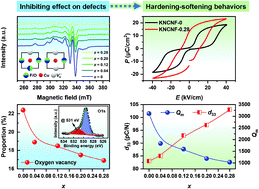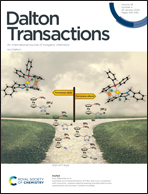Modulation of defects and electrical behaviors of Cu-doped KNN ceramics by fluorine–oxygen substitution†
Abstract
The lead-free piezoceramics of K0.5Na0.5Nb0.996Cu0.01O3−xFx (KNCNF-x) were synthesized via a conventional solid sintering process, and the inhibition effects of F–O substitution on the defect structures of oxygen vacancies and defect complexes were investigated. The KNCNF-0 ceramic without F doping has the highest level of oxygen vacancies and defect complexes. However, as the level of F increases, the contents of oxygen vacancies and defect complexes decrease correspondingly, and thus, the evolution of hardening to softening behaviors in the ceramics is observed. As a result, the KNCNF-0 piezoceramic shows extremely hardened electrical behaviors (a completely constricted P–E hysteresis loop, large Ei of 10.7 kV cm−1, kp of 38%, d33 of 83 pC N−1, Qm of 3110, and tan δ of 0.2%), while the ceramic with x = 0.28 exhibits softened ferroelectric and piezoelectric characteristics (a non-shrinking P–E hysteresis loop, declining Ei of 7.5 kV cm−1, enhanced kp of 42%, optimized d33 of 103 pC N−1, reduced Qm of 1031, and increased tan δ of 0.6%). This study provides new insights into the modulation of defects and electrical performance of KNN ceramics.



 Please wait while we load your content...
Please wait while we load your content...